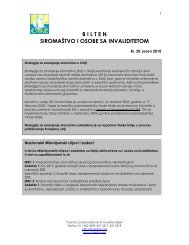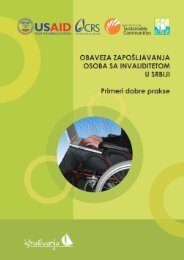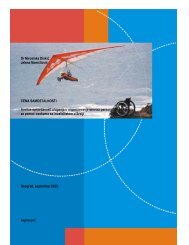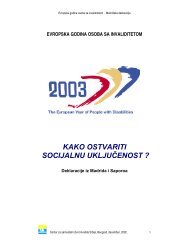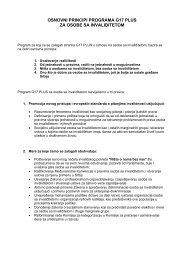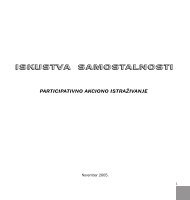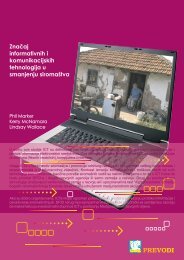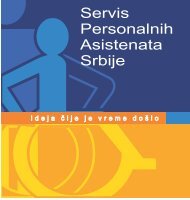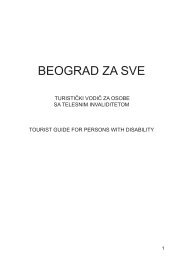ZAPOŠLJAVANJE OSOBA SA INVALIDITETOM U SRBIJI Moguænosti i izazovi
Preuzmite ovde - Centar za samostalni Život osoba sa invaliditetom ...
Preuzmite ovde - Centar za samostalni Život osoba sa invaliditetom ...
- No tags were found...
You also want an ePaper? Increase the reach of your titles
YUMPU automatically turns print PDFs into web optimized ePapers that Google loves.
istrazivanja<br />
Strategy in Serbia 2007-2015; National Strategy for Poverty Reduction; National<br />
Strategy of Employment, Law of Labor, Law on Preventing Discrimination on the<br />
Ground of Disability and Law on Professional Rehabilitation and Employment of<br />
PWDs. As well as that, different fiscal regulations and programs for Active employment<br />
policy give important support to employers who are employing PWDs.<br />
Survey on unemployed PWDs<br />
The first survey circle covered 124 unemployed PWDs looking for a job. Most of them<br />
are younger than 45 years of age (the most productive period of life). The second<br />
survey circle covered 132 unemployed PWDs. More than a half of them are between 19<br />
and 30 years of age. The reason for that change could be the fluctuation of labor force.<br />
Men were dominant in both questioning circles which differ from the general<br />
situation in Serbia where there are more unemployed women.<br />
According to type of settlement, more than two third unemployed PWDs in research<br />
sample live in urban area and the rest in suburban or country area.<br />
The level of education at unemployed PWDs showed that more than two third<br />
attended the grammar school, less than one third attend special schools. Almost the<br />
half of people interviewed completed the secondary education. In research sample of<br />
PWDs there are 14.5% with higher or high education. Unemployed PWDs has positive<br />
approach towards additional education and see it as important factor for the<br />
employment and development of their working carrier. On the other hand, they<br />
would not be able to afford it without additional support – more than a half of persons<br />
questioned stated that they need that kind of support.<br />
Majority of questioned PWDs have long lasting disability – only 10% of unemployed<br />
PWDs live with disability for the last ten years. Period of disability occurrence<br />
influences education and specific needs in professional rehabilitation. More than a<br />
half persons interviewed have physical disability, more than one third have sensory<br />
disability and less than one eight are persons with other types of disability.<br />
The existing system of disability status verification does not give the relevant data and<br />
information for labor market. The data that are missing are the evaluation of working<br />
capacities and redirection to jobs where PWDs could realize to optimum their working<br />
abilities.<br />
Most of interviewed PWDs do not require any specific support at working place. The<br />
help of other person during the working engagement is needed for one third of<br />
persons interviewed and it is related mostly to arrival/departure from the working<br />
place. This kind of help is more needed „outside of home“ than in performing<br />
everyday activities.<br />
Persons with disability are faced with lot of problems (access to transport, access to<br />
premises of National Employment Bureau, lack of orthopedic aids) and more than a<br />
16




